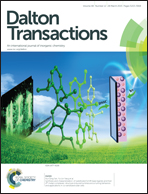Imidazole derivative-functionalized carbon dots: using as a fluorescent probe for detecting water and imaging of live cells†
Abstract
A highly sensitive carbon dot–imidazole (CD–imidazole) nanoprobe is prepared through covalently conjugating imidazole group onto the surface of carbon dots for water fluorescence. In organic solvents, quenching of fluorescence occurs via photoinduced electron transfer (PET) process from the imidazole nitrogen to the CD acceptor. Addition of a trace amount of water into CD nanocomposites in various organic solvents leads to a fluorescence turn-on response, which can be attributed to the suppression of PET due to the formation of the “free” ion pair by proton transfer from the carboxyl groups that are on the CDs surface to the imidazole nitrogen through a water-bridge. This phenomenon can be used for the highly selective detection of trace amounts of water in organic solvents. Laser confocal microscope experiment shows the potential utilization of CD–imidazole for the probed proton-transfer reactions in living cells.


 Please wait while we load your content...
Please wait while we load your content...